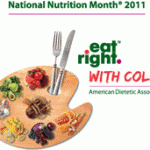Here at the Y, we are determined to improve our community’s health and well-being. One of the ways we do that is by educating you on healthy eating choices. Our YMCA of Central Florida provides you with dietary and nutrition education that will assist you in making the right choices for you and your family. With so little time and so much information, healthy eating can seem a daunting task. That’s why we have Registered Dietitian, Sharon Bartfield. She wants to share with you an easy way to choose healthy eating habits.

March is National Nutrition Month, a nutrition education campaign sponsored by the American Dietetic Association. Now that the holidays are behind us, it is a good time for a reminder about how to maintain healthful eating habits year round. Keep in mind that healthful eating habits are important at all age levels. Children grow, develop, and learn better when they are well nourished. Good nutrition is very beneficial for a healthy pregnancy. Teenagers and adults can be more productive and decrease their risk for many medical conditions if they maintain healthful eating habits. Food nourishes both the body and the mind. Being well nourished means not only eating enough of the nutrients your body needs but also eating foods in the right proportions to maintain a healthy weight.
So, if you want to improve your mood, increase your energy levels, and decrease your risk for diseases such as heart disease, cancer, and diabetes; then let’s create a festive meal with a palette of nutrients and “Eat Right With Color”.
Registered dietitian and ADA Spokesperson Karen Ansel offers ways to brighten up your plate in every season with this quick color guide.
Green produce indicates antioxidant potential and may help promote healthy vision and reduce cancer risks.
Fruits: avocado, apples, grapes, honeydew, kiwi and lime
Vegetables: artichoke, asparagus, broccoli, green beans, green peppers and leafy greens such as spinach
Orange and deep yellow fruits and vegetables contain nutrients that promote healthy vision and immunity, and reduce the risk of some cancers.
Fruits: apricot, cantaloupe, grapefruit, mango, papaya, peach and pineapple
Vegetables: carrots, yellow pepper, yellow corn and sweet potatoes
Purple and blue options may have antioxidant and anti-aging benefits and may help with memory, urinary tract health and reduced cancer risks.
Fruits: blackberries, blueberries, plums, raisins
Vegetables: eggplant, purple cabbage, purple-fleshed potato
Red indicates produce that may help maintain a healthy heart, vision, immunity and may reduce cancer risks.
Fruits: cherries, cranberries, pomegranate, red/pink grape fruit, red grapes and watermelon
Vegetables: beets, red onions, red peppers, red potatoes, rhubarb and tomatoes
White, tan and brown foods sometimes contain nutrients that may promote heart health and reduce cancer risks.
Fruits: banana, brown pear, dates and white peaches
Vegetables: cauliflower, mushrooms, onions, parsnips, turnips, white-fleshed potato and white corn
Ansel recommends choosing a variety of colors when shopping for seasonal fruits and vegetables. “And for additional options in the color palette, choose frozen or dried fruits and vegetables available throughout the year,” she says.
“Instead of grilled chicken and mashed potatoes, consider painting a more colorful plate, such as grilled chicken topped with salsa, mashed sweet potato, asparagus and spinach salad with orange slices. A colorful meal is not only visually appealing, but it also contains a variety of nutrients and is quite flavorful,” Ansel says.
For more information on how to “Eat Right with Color,” visit ADA’s National Nutrition Month website for a variety of helpful tips, fun games, promotional tools and nutrition education resources.
